Aylesford Priory
Aylesford Priory, or "The Friars" was founded in 1242 when members of the Carmelite order arrived in England from Mount Carmel in the Holy Land.[1] Richard de Grey, a crusader, sponsored them, and conveyed to the order a parcel of land located on his manor in Aylesford.
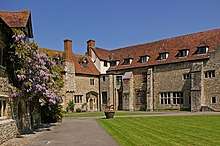
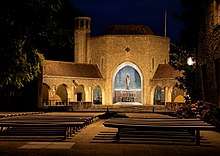
History
The Carmelites first came to Kent[2] in the 13th Century, Richard of Wendover[3] (the Bishop of Kent) recognised the Carmelite foundation at Aylesford and the first General Chapter outside of the Holy Land was held there. The Chapter effectively changed the lifestyle of the Carmelites from hermits to mendicant friars. Lots more of their history can be found on their website.[4]
Art at The Friars
The Friars has a fine collection of religious modern art with sculptures, paintings, stained glass and ceramics.[5] The restoration, followed by the building of the Shrine, began in the early 1950s when people were captivated after the distraction of the war years. The first Prior, Fr. Malachy Lynch was a charismatic figure who inspired people with the words "Courage to Build Anew[6]".
Philip Lindsey Clark [1] was the son of a sculptor and the father of a sculptor. As well as work in Westminster Cathedral and many churches, his commissions include several War Memorials. As Chair of the Religious Artist Guild, he introduced both Adam Kossoswski and his son Michael Clark.
Michael Clark [1] is known mainly for his religious sculptures. His first ever commission was the little statues over the doorways of the Courtyard. He was awarded the Otto Beit Medal for Sculpture for his statue of the Glorious Assumption.
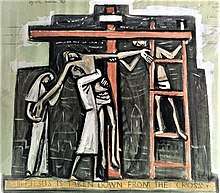
Adam Kossowski was born in Poland and studied in the Cracow and Warsaw Academies of Art. He began work at Aylesford in 1950 and worked here for more than twenty-five years. His work includes murals, scraffito, stained glass, wrought iron and most famous of all the ceramics.[7]
The Stained Glass Windows
Moira Forsyth was one of the outstanding stained glass artists of the last century. The Flos Carmeli window was a personal gift of the artist as she was received into the Catholic Church in the Cloister Chapel on the Feast of Our Lady’s birthday, 1957. The Flos Carmeli (Flower of Carmel) is the first line of a hymn that Carmelites sing to Our Lady.
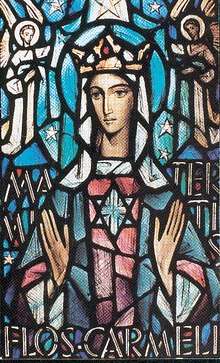
Dom Charles Norris is responsible for the windows in the Relic Chapel. The ones in the body of the chapel were designed by Adam Kossowski, while the ones in the side chapel were designed by Norris himself. He developed a style of stained glass called ‘dalles de verre’ that is slab glass set in concrete, though the ones in the body of the chapel are set in resin.
The diamond designed windows in the Choir Chapel; the tribune of the Relic Chapel and St. Joseph’s Chapel; the spring of faith windows in St. Anne’s Chapel and the gold, brown and orange tinted windows in the old Convent Chapel are all windows made at Hartley Wood Glass, Sunderland.
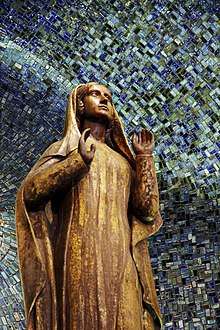
Shrine
The medieval building includes the Prior’s Hall; two walks of the Cloisters; the Cloister Chapel and the Courtyard with the Pilgrims’ Hall which stands beside the River Medway. .[5]
Behind the Shrine is the Rosary Way and just before the start of the Rosary Way the Peace Garden can be found. There are two restored barns by the main entrance one of which houses the Tearoom and Giftshop. This barn dates to the seventeenth century.[7] Adrian Gilbert Scott, the architect of the Shrine,[7] was a member of the family who have been described as "the family who built Gothic Britain". His older brother was Giles Gilbert Scott and their father was George Gilbert Scott Jr.
Pottery
Aylesford Pottery, located at the site of the Priory, was founded by David Leach in 1954, today is a working pottery with showroom. The Aylesford Pottery is one of the few surviving commercial potteries in the south east of England making a range of handmade thrown and hand-built ceramics, plus architectural commissions. Two master potters Alan Parris and Billy Byles run the pottery today.[7]
Burials
- Mazilia (or Marcelin/Mascelin) de Braci, wife of William de Cantilupe (died 1239)
- Simon Stock
References
| Wikimedia Commons has media related to Aylesford Priory. |
- "History". www.thefriars.org.uk.
- "History of Kent", Wikipedia, 15 January 2020, retrieved 18 February 2020
- "The city and liberty of Rochester: The diocese, bishops and archdeacons | British History Online". www.british-history.ac.uk. Retrieved 18 February 2020.
- "The Friars - Aylesford Priory, Maidstone, Kent". www.thefriars.org.uk. 29 August 2018. Retrieved 18 February 2020.
- https://www.artway.eu/artway.php?id=550&action=show&lang=en
- Fielding, Edwina. (1968). Courage to build anew: the story of the rebuilding of The Friars, Aylesford, taken from the newsletters of Malachy Lynch;. Lynch, Malachy. London: Burns & Oates. ISBN 0-223-31392-0. OCLC 41032.
- "Attractions". www.thefriars.org.uk.
Further reading
- The History of The Friars Aylesford by Fr Wilfrid McGreal O Carm
- Carmel in Britain, Essays on the Medieval English Carmelite Province by Patrick Fitzgerald-Lombard O.Carm
- The Friars Aylesford by James H. Sephton
- Courage to Build a New by Edwina Fielding
- Image of Carmel The Art of Aylesford by the Carmelite Friars of Aylesford
- Adam Kossowski by Benedict Read